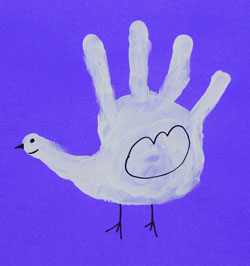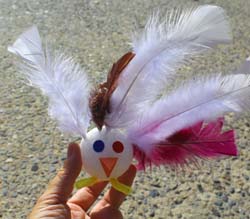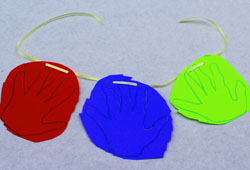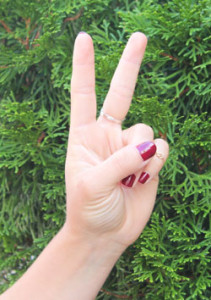 Every year on September 21 (which happens to be my wedding anniversary), people from around the world observe the International Day of Peace. Established by the United Nations General Assembly in 1981, it was initially celebrated on the third Tuesday of September which is the start date of the U.N.’s annual session. In 2001, the September 21st date was chosen, which means World Peace Day falls on Sunday this year. I already wrote a Bible Unbound column on Peace, so I decided to focus this peace-related post on kids.
Every year on September 21 (which happens to be my wedding anniversary), people from around the world observe the International Day of Peace. Established by the United Nations General Assembly in 1981, it was initially celebrated on the third Tuesday of September which is the start date of the U.N.’s annual session. In 2001, the September 21st date was chosen, which means World Peace Day falls on Sunday this year. I already wrote a Bible Unbound column on Peace, so I decided to focus this peace-related post on kids.
If you like festivals, start by checking out events in your area. In Asheville, our local university (UNC-A) has organized a Peace Day festival that runs from noon until 10PM. The schedule includes speakers, concerts, demonstrations, classes, and free food. From 1-4PM they will also host activities directly targeting kids and families.
If you prefer a more classroom- or home-centered approach, check out these suggestions for go-to books and easy crafts. Our Sunday School curriculum includes an entire unit called Peace. The lesson plans focus on stories and passages from the Bible and other sacred texts that teach about peace in some way. We have four different age groups, so we’ve spent a lot of time developing age-appropriate activities for kids. It’s pretty easy to help kids understand what peace means and how they can become peace-makers/keepers, so jump on the peace bandwagon and get started!
Books
Many parents I’ve talked with are skeptical that kids – especially young kids – can comprehend what “peace” is since it’s such an abstract concept. Certainly, this is what you would predict based on a century of research in child development! However, there is a very easy solution to this dilemma: make “peace” a concrete concept. This approach works well even for slightly older kids, but there’s no need to reinvent the wheel. Many authors and publishers have already figured this out, so head to your local library and see what they have to offer. Here are our recommendations.
Preschool-K
The Peace Book by Todd Parr (Little, Brown, and Company – 2004/2009)
Parr is known worldwide for his brightly-colored, yet simple, illustrations and for his ability to elucidate complex ideas. Each page offers a one-line suggestion about what peace might look like. Ideas such as “offering a hug” or “listening to different types of music” highlight his primary point — peace is about being kind and accepting both to ourselves and to others.
A Little Peace by Barbara Kerley (National Geographic Society – 2007)
Part of the National Geographic Children’s Book series, this text also uses very short phrases to describe how each of us can bring peace to the world. The National Geographic photos are every bit as beautiful as you would expect, and background information is offered on each photo at the end of the book.
Can you Say Peace? by Karen Katz (Henry Holt and Company – 2006)
This book teaches kids how to say the word “peace” in different languages. The left-hand page provides the name of a country along with a colorful image depicting the culture of that country. The right-hand page gives the word “peace” in that country’s primary language, along with a second colorful image of a child who represents that country. (Pronunciation help is also included.)
Lower Elementary
What Does Peace Feel Like? by Vladimir Radunsky (Atheneum Books for Young Readers – 2004)
This is the book we use most often with this age group. The book works its way through the senses (e.g., what does peace smell like, what does peace sound like). For each sense, answers provided by children attending the Ambrit International School in Rome offer initial suggestions. Then, readers are prompted to share their own ideas. You might think this book simply substitutes one set of abstract concepts for another, but our experience is that kids in this age group have a lot of say when taught about peace in this way. A long list of words meaning “peace” in other languages can also be found at the back.
Peacefulness by Lucia Raatma (Bridgestone Books – 2000) and Being a Peacekeeper by Pam Scheunemann (ABDO Publishing – 2004)
These books are part of their own separate series, but they are very similar. Each page offers a few lines about things kids can do to bring peace to the world. The text is accompanied by uncomplicated photographs of real children. The text for Being a Peacekeeper is a bit shorter (only 2 lines per page) and could be used with a Preschool-K group, as well.
Peace Week in Miss Fox’s Class by Eileen Spinelli (author) and Anne Kennedy (illus.) (Albert Whitman and Co. – 2009)
This is one of the few fictional storybooks out there. Miss Fox, a teacher, is tired of all the squabbling between the animal students in her class, so she declares a Peace Week. Each day, a conflict arises, and the animal students figure out ways to resolve it peacefully. This book is more conversational than all the others which helps keep kids’ interest.
Wangari’s Trees of Peace by Jeanette Winter (Harcourt, Inc. – 2008)
This book tells the true story of Wangari Maathai, winner of the 2004 Nobel Peace Prize for founding of the Green Belt Movement in Kenya. To combat the deforestation of her country, she began planting trees which are a symbol of peace in the African tradition. Millions of trees have been planted over the years, and the movement has spread to dozens of other countries. We love this book, and we have often used it on Earth Day.
Upper Elementary
Paths to Peace: People who Changed the World by Jane Breskin Zalben (Dutton Children’s Books – 2006)
We don’t usually read to the kids in our Upper Elementary group, but this book offers nice, one-page descriptions of various Nobel Peace Prize winners. We often pick one or two short bios. to read if we have time remaining at the end of our Sunday School class.
Crafts
Many of these crafts would look more attractive if they were made using fabric or felt; however, we almost always use paper. Paper is inexpensive, it is easy for kids to write/draw on, it doesn’t require the use of permanent fabric markers, and it doesn’t require sewing.
Peace Quilt
We usually start our unit by making a peace quilt. We do this as a group project, but it can be done as an individual or family project, as well.
Each child is given a 5” x 5” square of paper (any kind, any color), and we ask them to write or draw something that is peace-related. Depending on their age, creative skills, and interest level, they might:
- write the word “peace” in English or in another language
- draw something that brings peace to the world or that simply makes people smile (like a flower, a rainbow, a heart, or a happy face)
- describe or depict a peaceful scenario (like sharing a toy or sitting by a waterfall)
- draw a typical peace symbol (like a dove, a peace sign, or a peace gesture made with hands)
When everyone has finished at least one square (they can certainly do more), we glue them all onto a large, black background (made of posterboard, fabric, or craft felt). I usually cut out some letters to label the quilt at the top. Then, we hang it where everyone can enjoy it.
Other Crafts
Additional craft ideas can easily be found on line. Peace crafts generally fall into three categories: dove crafts, peace sign crafts, and handprint crafts. There are an infinite number of variations and combinations on these themes. Here are some of the projects we do.
Make a dove from paper or from a handprint. (Note: painted handprints only look like this if they’ve been touched up after making the print.) Our youngest group of kids recently made little doves using small Styrofoam balls, thumbtacks, small sections of pipe cleaner, and feathers. The only thing that needed glue was the beak.
Cut a peace sign from light-weight cardboard, recycled cereal boxes, or a paper plate. Then, cover it with any number of things. I’ve seen them covered with shells, stickers, tissue paper, glitter, and pom-poms. We cover ours with small images of flags from around the world.
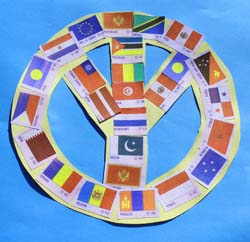
Let everyone trace around their hands and cut them out. The youngest kids might need help with the cutting part, but remember that they do not have to cut out each digit; they can simply cut or tear around the handprint. Kids can write their names on the handprints, or if you prefer to stick with the theme, they can write peace ideas on each one. Once you have several handprints, make a group craft from them. You could make a handprint banner/swag by punching holes near the top and running a long piece of yarn/ribbon through them. You could also place the handprints in some version of a circle. Some people also add an image of a dove, a peace sign, or the earth to the center of the circle.
Several designs have been proposed for a universal peace flag. Although the U.N. has yet to officially adopt such a flag, it’s easy to create coloring pages from some of these designs. One year, we used a design that shows a rainbow background and the word “Peace” in white letters. The kids colored the flag and then applied letters that I printed out on white sticker paper.
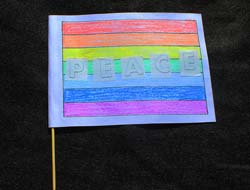
Finally, I will put in a brief plug for the International Art Exchange for Peace. Every other spring, registered groups exchange art with a group from another part of the world. We have successfully participated twice, and our kids were so excited when they received art and photographs from the island of Cyprus (in 2012) and from the Netherlands (in 2014). The next exchange is not until 2016, but I highly recommend marking your calendars now and participating if you can. Here’s one of the projects we sent across the ocean.
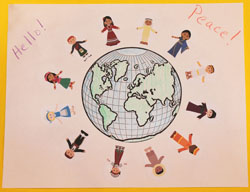
Obviously, the most important point is to celebrate the International Day of Peace! It’s a great excuse to get kids thinking about and talking about peace, which they are more than able to do. But don’t feel like you’re alone in this venture. There are plenty of readily-available resources out there, and this post simply scratches the surface. Just remember: the crafts and the books will eventually end up in a trash heap somewhere, but the message of peace will live on indefinitely.
